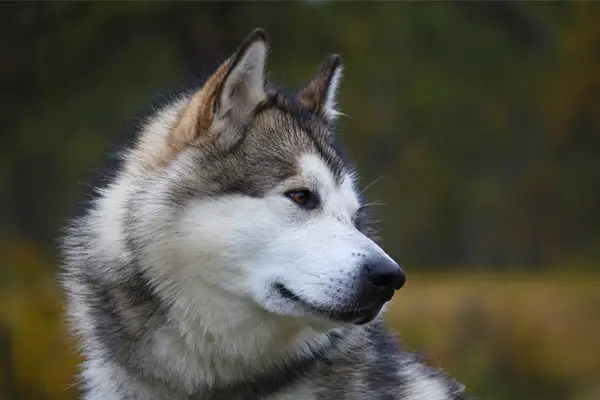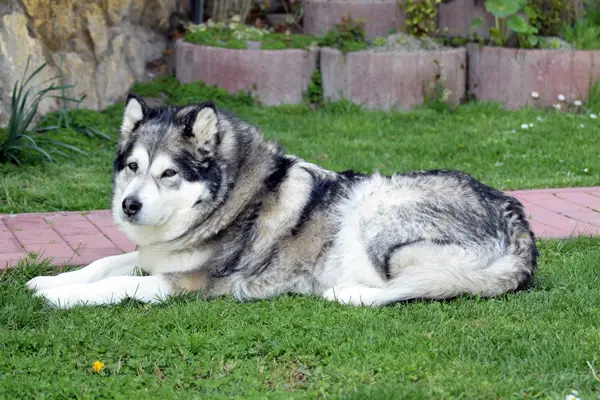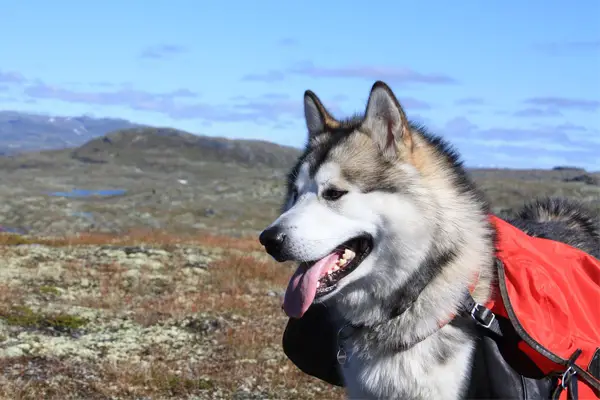The Alaskan Malamute is a large-sized dog breed known for its close resemblance to Siberian Huskies. These dogs have a strong body and are known to have great stamina and strength. It is also impressive that it’s one of the oldest dog breeds that retained their original characteristics.
As intelligent dogs, they are not great pets for new and inexperienced owners. These dogs can be too much to handle – needing a lot of attention and space. If you don’t like a lot of hair all over your floor, you might want to reconsider purchasing an Alaskan Malamute.
But if you happen to be the right person, these dogs are wonderful additions to your family. They are gentle, playful, friendly, and, most especially, good with kids.

Alaskan Malamute Statistics
| Dog Breed Group | Working |
| Breed Size | Large |
| Height | 25 inches (male); 23 inches (female) |
| Weight | 85 pounds (male); 75 pounds (female) |
| Lifespan | 10-14 years |
Alaskan Malamute Ratings
| Energy level | |
| Exercise needs | |
| Requires attention | |
| Playfulness | |
| Trainability | |
| Shedding | |
| Grooming | |
| Friendly with family | |
| Friendly with kids | |
| Friendly with strangers | |
| Friendly with other dogs | |
| Prey Drive |
Alaskan Malamute History
The history of Alaskan Malamute goes way back centuries, and as their name implies, they are a native dog to Alaska. They are among the oldest of the sled dog breeds of the Arctic and known for their tremendous strength, energy, endurance, independence, and intelligence.
The name Malamute came from the word “Mahlemiut,” the name of an Inuit tribe in Alaska. The Alaskan Malamute dogs were used as sled dogs by the tribe, and like wolves, they worked in packs to haul heavy objects over long distances.
When the Gold Rush came in 186, the Malamute dogs almost became extinct. Native dogs were bred with the Malamutes, and the pure breed’s number started to decline. Since the natives valued the dog so much, they isolated the tribe, and the breed survived.
As years passed, several strains developed in the Malamute breed – the Kotzebue strain and the M’Loot strain. This was around the 1930s. And by 1935, the American Kennel Club officially registered the breed.
When World War II erupted, most registered Alaskan Malamutes were loaned out for war duty to assist. They were mostly used as sled dogs, and a lot of them died during that war.
It’s said that all Alaskan Malamutes registered with the American Kennel Club can be traced back to the Kotzebue’s strain, and they also remain to be one of the least altered dog breeds.

Alaskan Malamute Temperament
Alaskan Malamutes may be large dogs that resemble a wolf. However, their personality is so far from that. These dogs are known to be affectionate, loyal, and playful.
These dogs are not for owners who can’t give them enough attention. They are highly energetic and certainly love the outdoors. If not given the right amount of exercise, they can become destructive, will not stop howling, and can chew on your furniture.
But, if provided the right care, they are loving family members. They are friendly with everyone, even with strangers, so they may not be good watchdogs. They are also known to be good and gentle with children.
The only concern is that some Alaskan Malamutes show aggression towards other animals. They love to be dominant among other dogs and show some predatory instincts with smaller pets. They’re best in one-dog households.
Training an Alaskan Malamute can be a challenge, so you must establish yourself as an alpha. Be consistent and don’t be intimidated by his demanding personality. Early socialization is essential, too, if you want them to be more well-rounded inside your homes.
Alaskan Malamute Care Requirements
- Nutrition: Alaskan Malamutes are very energetic dogs and require a high-quality diet that can provide the energy they need. The diet should be well-balanced and must contain all the essential nutrients such as protein, carbohydrates, fats, vitamins, and minerals. Protein is most essential for his diet. If you prefer raw food, then there’s no problem at all. Just make sure only to buy high-quality animal meat. You can then supplement this with some carbohydrates from cooked brown rice, fiber from fruits and vegetables, and some fats. If you prefer dry food, make sure only to buy premium high-quality ones, and it should contain animal-based protein as the main ingredient. Avoid dog food containing fillers, by-products, and artificial flavoring as these can’t be digested easily.
- Grooming: If there’s one thing you have to prepare for if you want to get an Alaskan Malamute, it’s a LOT of hair. These dogs have a thick, waterproof double coat that sheds a lot. They should be brushed daily to remove loose hair, mats, and other debris. They should also be bathed regularly, at least every six to eight weeks. But Alaskan Malamutes used for shows are often washed weekly, depending on what’s needed. Since these dogs are tolerant of cold, they don’t have any problems with water. Ears should be checked and cleaned regularly. Make sure that their nails are kept short to make them very comfortable.
- Exercise: Alaskan Malamutes are working dogs, which means they need a lot of activities. These dogs are known for their endurance, and they enjoy sled work when they carry heavy loads for long distances. If you want to give this dog a job, then this should be it. However, if you don’t, long daily walks should suffice. Or, you can have him romp around your backyard until he expels all his excess energy. Just make sure to secure the fence well, so he doesn’t go out or chase after small animals around. If you love outdoors, then these dogs are excellent companions for hiking, running, and swimming. You can also have him participate in dog sports such as agility, obedience, weight pulling, backpacking, and of course, his favorite, sledding.
- Health: As Alaskan Malamutes didn’t have a lot of alteration for several centuries, there might only be a few diseases you need to be concerned about. One of these is hip dysplasia, a genetic deformity that affects the dog’s walking later in life. Another one is chondrodysplasia, which is an abnormality in the dog’s cartilage and might lead to dwarfism. And lastly, is polyneuropathy which is a nervous system disorder. These diseases are mostly genetic health conditions. It will help if you can check with the dog’s parents, so you’ll know if any is existing from them. You can also have your dog get some screening tests if one is available.
- Lifespan: The life expectancy of Alaskan Malamutes is 10-14 years.

Famous Alaskan Malamutes
Toro: The first dog to unite all strains of the Alaskan Malamutes.
Fun Facts About Alaskan Malamutes
- Alaskan Malamute is an ancient dog breed; they are believed to have been first developed by a tribe of Inuit.
- They were almost wiped out at the end of the 1800s, during the Gold Rush.
- They have superior load-lifting ability.
- They are the biggest of all Nordic Sledge Dogs.
- There have been three strains of Malamutes, but only two of which are known – Kotzebue and M’Loot.
- They are one of the few dog breeds whose ancestry is least altered.
